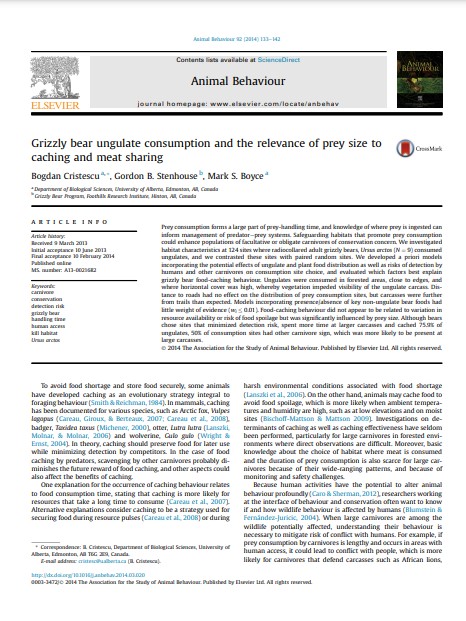Grizzly bear ungulate consumption and the relevance of prey size to caching and meat sharing.
Bosque Modelo:
Foothills
Temática:
Conservación
Tipo de documento:
Artículo científico
Resumen
Prey consumption forms a large part of prey-handling time, and knowledge of where prey is ingested can inform management of predatoreprey systems. Safeguarding habitats that promote prey consumption could enhance populations of facultative or obligate carnivores of conservation concern. We investigated habitat characteristics at 124 sites where radiocollared adult grizzly bears, Ursus arctos (N ¼ 9) consumed ungulates, and we contrasted these sites with paired random sites. We developed a priori models incorporating the potential effects of ungulate and plant food distribution as well as risks of detection by humans and other carnivores on consumption site choice, and evaluated which factors best explain grizzly bear food-caching behaviour. Ungulates were consumed in forested areas, close to edges, and where horizontal cover was high, whereby vegetation impeded visibility of the ungulate carcass. Distance to roads had no effect on the distribution of prey consumption sites, but carcasses were further from trails than expected. Models incorporating presence/absence of key non-ungulate bear foods had little weight of evidence (wi 0.01). Food-caching behaviour did not appear to be related to variation in resource availability or risk of food spoilage but was significantly influenced by prey size. Although bears chose sites that minimized detection risk, spent more time at larger carcasses and cached 75.9% of ungulates, 50% of consumption sites had other carnivore sign, which was more likely to be present at large carcasses.
Información Bibliográfica
Autor:
Cristescu, B., Stenhouse, G.B., Boyce, M.S.
Revista:
Animal Behaviour
Año:
2014
N°:
-
País :
Canadá
Páginas:
133 - 142
Volumen:
92
Idioma:
Ingles
Palabras claves
carnivore conservation detection risk grizzly bear handling time human access kill habitat Ursus arctos





